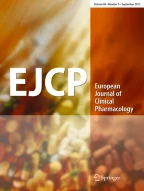Summary
The utility of a new microprocessor-based method for continuous monitoring of compliance in taking solid medicaments has been evaluated. Medication intake in 31 ambulant patients was assessed in a prospective observational study under the conditions of routine practice. The patients (aged 14–87 y, mean 50 y) were receiving long-term drug treatment for various chronic diseases.
There was marked interindividual and intraindividual variation in compliance with different drugs. Deviations from the prescribed dosage regimens were caused by omission of doses (22.7% of prescribed doses) and intake of extra doses (5.6% of prescribed doses). Continuous monitoring revealed that in 19% of the monitoring period no medication was taken, in 13% there was partial intake, and in 8% extra doses were taken. Patient-initiated drug holidays occurred in 50% of patients. They were responsible for 76% of the medication-free time.
It is concluded, that continuous compliance monitoring is practicable in ambulatory patients. It provides information about the dynamics of drug intake behaviour that cannot be obtained from medical histories or from clinical or laboratory examination. The information could be used effectively in individual patient care and in clinical drug trials.
Similar content being viewed by others
References
Gordis L (1979) Conceptual and methodological problems in measuring patient compliance. In: Haynes RB, Taylor DW, Sackett DL (eds) Compliance in health care. Johns Hopkins University Press, Baltimore
Norell SE, Granström P-A, Wassen R (1980) A medication monitor and fluorescein technique designed to study medication behaviour. Acta Ophthalmol 58: 459–467
Keram S, Williams ME (1988) Quantifying the ease of difficulty older persons experience in opening medication containers. J Am Geriatr Soc 36: 198–201
Rudd P, Marshall G, Taylor CB, Agras WS (1981) Medication monitor/dispenser for pharmacological and compliance research. Clin Pharmacol Ther 29: 278
Weintraub M (1976) Intelligent and capricious non-compliance. In: Lasagna L (ed) Patient compliance. Future, Mt. Kisco
Blackwell B (1979) The drug regimen and treatment compliance. In: Haynes RB, Taylor DW, Sackett DL (eds) Compliance in health care. Johns Hopkins University Press, Baltimore
Haynes RB (1979) Determinants of compliance: The disease and mechanics of treatment. In: Haynes RB, Taylor DW, Sackett DL (eds) Compliance in health care. Johns Hopkins University Press, Baltimore
Spriet A, Bieler D, Dechorgnat J, Simon P (1980) Adherence of elderly patients to treatment with pentoxifylline. Clin Pharmacol Ther 27: 1–8
Norell SE (1981) Monitoring compliance with pilocarpine therapy. Am J Ophthalmol 92: 727–731
Guayatt G, Sackett DL, Taylor DW, Chong J, Roberts R, Pugsley S (1986) Determining optimal therapy — Randomized trials in individual patients. N Engl J Med 314: 889–892
Bergman U, Wiholm B-E (1981) Drug-related problems causing admissions to a medical clinic. Eur J Clin Pharmacol 20: 193–200
Levy M, Mermelstein L, Hemo D (1982) Medical admissions due to non-compliance with drug therapy. Int J Clin Pharmacol Ther Toxicol 20: 600–604
Graham H, Livesly B (1983) Can readmissions to a geriatric medical unit be prevented? Lancet I: 404–406
Davidsen F, Haghfelt T, Gram LF, Brøsen K (1988) Adverse drug reactions and drug non-compliance as primary causes of admissions to a cardiology department. Eur J Clin Pharmacol 34: 83–86
Grymonpre RE, Mitenko PA, Sitar DS, Aoki FY, Montgomery PR (1988) Drug-associated hospital admissions in older medical patients. J Am Geriatr Soc 36: 1092–1098
Cramer JA, Mattson RH, Prevey ML, Scheyer RD, Quellette VL (1989) How often is medication taken as prescribed? A novel assessment technique. JAMA 261: 3273–3277
Haynes RB, Sackett DL, Taylor RW, Roberts RG, Johnson AL (1977) Manipulation of the therapeutic regimen to improve compliance: conceptions and misconceptions. Clin Pharmacol Ther 22: 125–130
Pullar T, Birkwell AJ, Will PG, Hay A, Feely MP (1988) Use of pharmacologic indicator to compare compliance with tablets prescribed to take once, twice or three times daily. Clin Pharmacol Ther 44: 540–545
Prinoth M, Spahn H, Mutschler E (1986) The development of reliable compliance tests for anti hypertensive drugs. Eur J Clin Pharmacol 29: 535–539
Joyce CRB (1962) Patient co-operation and the sensitivity of clinical trials. J Chron Dis 15: 1025–1036
Norell SE (1983) Methods in assessing drug compliance. Acta Med Scand [Suppl] 683: 35–40
Author information
Authors and Affiliations
Rights and permissions
About this article
Cite this article
Kruse, W., Weber, E. Dynamics of drug regimen compliance — its assessment by microprocessor-based monitoring. Eur J Clin Pharmacol 38, 561–565 (1990). https://doi.org/10.1007/BF00278582
Received:
Accepted:
Issue Date:
DOI: https://doi.org/10.1007/BF00278582
